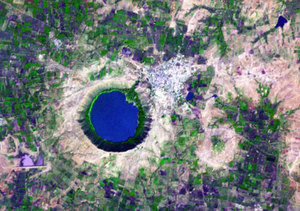
|
| ©SPACE.com |
NASA's Terra satellite acquired this image of Lonar Crater in India, using the Advanced Spaceborne Thermal Emission and Reflection Radiometer (ASTER) instrument. This astrobleme (a space-caused earth blemish) is located in the Buldhana district of Maharashtra State, India.
British officer C. J. E. Alexander identified the crater in 1823, although it was initially thought to have arisen from volcanic activity. This assumption makes sense, as the geologic feature sits in the Deccan Plateau, a plain of volcanic basalt rock that emerged from eruptions 65 million years ago. Scientists have since revised the explanation, making the crater the result of a meteorite impact, this decision having been largely influenced by the presence of maskelynite, a naturally occurring glass that only results from high-velocity impacts.
Lonar Crater dips approximately 500 feet (150 meters) down, with an average diameter of almost 6,000 feet (1,830 meters). The crater rim rises roughly 65 feet (20 meters) above the surrounding land.
In this simulated-true-color image, a vegetation-lined lake occupies the crater, one of only a few natural features in this scene. Many indications of human activity surround the lake.
Lonar Crater's status as the Earth's only impact crater in volcanic basalt make it similar to impact craters on the moon.
* Video: Killer Comets and Ominous Asteroids!
* VIDEO: The Asteroid Paradox
* All About Meteors
Credit: Jesse Allen, data courtesy of NASA/GSFC/METI/ERSDAC/JAROS and U.S./Japan ASTER Science Team.



Reader Comments
to our Newsletter